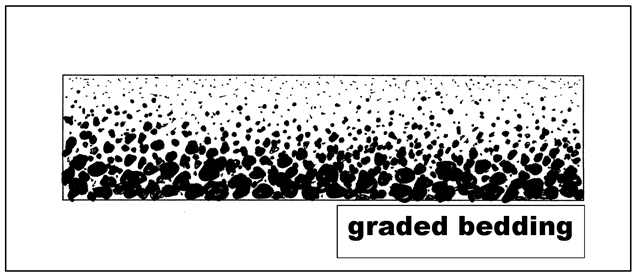[JP]
Additional Waypoint "Parking 2"や公開座標から見える海岸では、下の写真のように、黒い層と白い層の繰り返しがみごとなコントラストを作り出す凹凸の地形が観察されます。出っ張っているのは白い色をした砂岩層、へこんでいるのは黒い色をした泥岩層で、砂岩層と泥岩層が交互に堆積したものは砂岩泥岩互層と呼ばれます。この凹凸が繰り返す地形は、かつてはよく目にした洗濯板に形が似ていることから、洗濯岩と呼ばれています。
[EN]
From Additional Waypoint "Parking 2" or the published coords, you can observe a land feature as shown in the pictures below, in which land feature, repetition of convex white layers and concave black layers assumes splendid contrast. The convex white layers are sandstone layers and the concave black layers are mudstone layers. Structure formed by repetitive deposition of sandstone layers and mudstone layers is called as "sandstone-mudstone alternative layers". This convex-concave structure is called as "washboard rock" in Japan, as it looks like a washboard which used to be used.
[JP]
この地形自体は、過去およそ6千年程度の間にできたと推定されますが、地層そのものは、はるか昔のおよそ1,400万年前にできたものです。
[EN]
The land feature here has been formed over the past 6000 years. However, strata themselves were formed long long time ago, 14 million years age, under the sea.
[JP]
今の海岸で地層が傾いているのは、地層がたまったあと、島根半島が隆起をしたことと関係していると考えられます。1400万年もの長い時間をかけ、大地に大きな力が作用することで、深い海でたまった地層が地表に持ち上げられ、それがさまざまな侵食作用を受けたことで、このような洗濯岩ができたわけです。
[EN]
The present strate here slant, because Shimane peninsula has upthrusted after they deposited. After the strata deposited under the deep sea, they have upthrusted and been weathered, and turned into "washboard rock."



砂岩泥岩互層のでき方/How sandstone-mudstone alternative layers were formed?
[JP]
砂岩泥岩互層は、普段は泥が堆積しているような場所に、ときどき地震などによって、砂と泥が混じった混濁流(タービディティ・カンレト)によって砂がもたらされるような環境に形成されます。砂岩とその上の泥岩(の一部)が一回の混濁流に対応すると考えられ、タービダイトという岩石名で呼ばれます。
[EN]
Sandstone-mudstone alternative layers are formed in an environment where sand is sometimes brought with turbidity currents (mixture of sand and mud) caused by earthquake etc. to places where mud usually deposits. Layers formed by turbidity currents are called as "turbidite", in which you can observe "graded bedding" as explained below.
洗濯岩のでき方/How washboard rocks were formed?
[JP]
泥岩は水を含みやすく、波打ち際のような場所では濡れと乾燥の繰り返しにより膨張・収縮が繰り返されるために風化されやすく、砂岩層より先に風化されます。このため、砂岩層が凸部、泥岩層が凹部となった構造である洗濯岩が形成されます。
[EN]
Mudstone is less resistant to weathering than sandstone, as mudstone is likely to absorb water therein, and repeatedly expands and shrinks when getting wet and dried on the edge of the sea water, and thus becomes brittle. Because of that, the structure, "washboard rock", with convex portions of sandstone layers and concave portions of mud layers is formed.
級化層理/Graded bedding
[JP]
様々な粒度の石、砂や泥が混ざったタービディティ・カレント(混濁流)により運ばれた堆積物によって形成されるタービダイト中には、「級化層理」が発達していることが観察されます。
級化層理とは、粒径が大きな粒子ほど早く沈降することに起因して、単層の断面で,下から上に向かって堆積粒子の粒径が粗粒から細粒へと連続的に変化する構造を言います(下図. Washington State Colleges websiteから引用)。粒径の変化の方向を観察することによって、その層が水中で堆積した際に、どちらが上向きだったかを判断することができます。
[EN]
In turbidite, a type of rock formed with sediments carried by turbidity currents with mixture of particles having a range of grain sizes, like stones, sands and mud, you can observe that "graded bedding" was developed.
Graded bedding is a structure in which, because the larger the particle size is, the faster the particle settles out, the grain sizes of the sediment particles gradually change from the base of the bed to the top (see the figure below. Cited from the website of Washington State Colleges). By observing the direction of change of the grain sizes, you can tell which is the upper direction of the bed when it settled out in the water.

Task 1
[JP]
Found logを書く前に以下のクイズの回答をキャッシュオーナーに送ってください。
[EN]
Before claiming your found log, send your answers for the quizzes below to the cache owner.
Quiz 1
[JP]
洗濯岩の凸部分である砂岩(下写真で(a)で示した部分)と凹部分である泥岩(下写真で(b)で示した部分)の触って観察してみましょう。どのような違いがありますか? その違いにより、何故凹凸構造ができたのでしょうか?
[EN]
Touch and observe convex portions (like (a) portion shown in the picture below) and concave portions (like (b) portion) of the washboard rock. What differences did you observe? Why has the convex-concave structure been formed by the differences?

Quiz 2
[JP]
この砂岩泥岩互層が海中で堆積した当時の上側は現在北を向いているでしょうか、それとも南を向いているでしょうか?何故そのように言えるでしょうか?砂岩層内を詳しく観察して答えましょう。上記の説明をよく読み、下の写真で赤い丸で囲んだ付近の砂岩層を観察するとよいでしょう。
[EN]
In which orientation of north and south is the upper side of the strata when they were deposited under the sea facing now? Why did you think so? Please answer by reading the description above and observing cross-section of the sandstone layers in detail, for example around the area encircled with the red circle in the picture below.

Task 2(Optional)
[JP]
(Optional)洗濯岩を背景に写真を撮ってFound logと共にアップロードしてください。
[EN]
(Optional)Take a picture in front of the washboard rock and upload it to your found log.